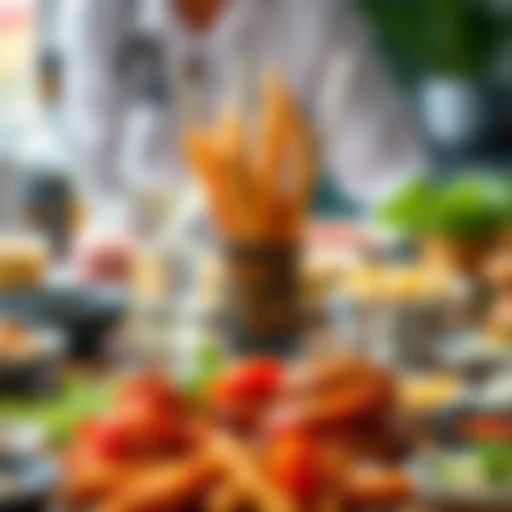Choosing the Best Chef Knife: A Complete Guide for Home Cooks
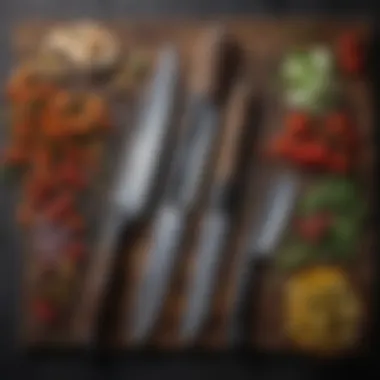
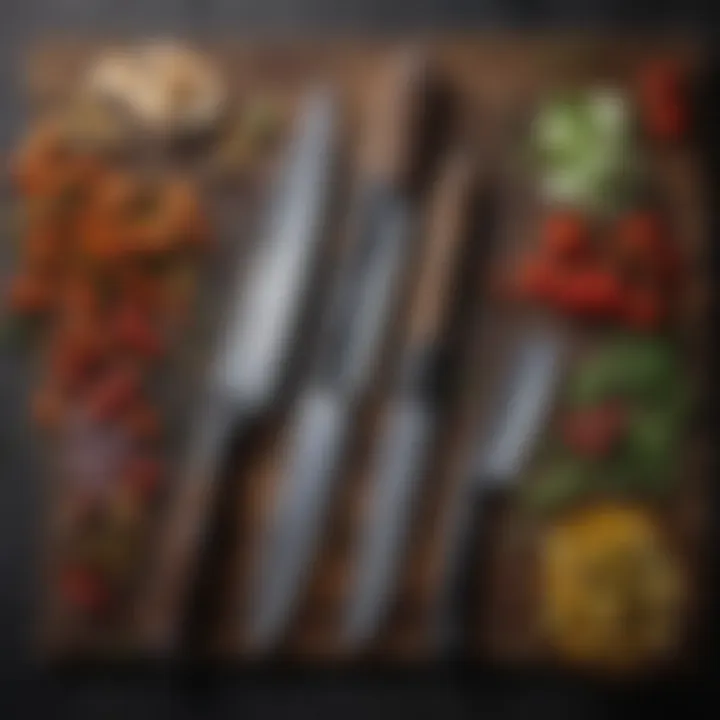
Intro
Choosing the right chef knife can impact cooking experiences significantly. A great knife can enhance precision and comfort, while a poor choice can hinder performance. Chef knives are versatile tools in the kitchen. This guide serves to highlight various key elements surrounding chef knives, especially targeted at home cooks.
The article explores types of chef knives that can complement specific cooking styles. Understanding the features, maintenance, and user experiences will enable readers to make informed decisions.
Why It Matters
A quality chef knife allows cooks to handle various tasks, from chopping vegetables to slicing meat. Every home cook, whether a novice or an expert, can benefit from selecting the right knife. The right utensil not only improves efficiency but also enhances the overall cooking experience.
"The kitchen knife is the single most important tool in any cook's toolbox. Selecting the right one can elevate your cooking!"
In a world with numerous options, finding the best chef knife could feel overwhelming. This guide aims to make that process easier by providing clear information and practical advice.
Understanding the Chef Knife
Understanding the chef knife is crucial for any home cook who wants to elevate their culinary skills. This section intends to lay a solid foundation by explaining what a chef knife is, its purpose, and how it has evolved over time. A comprehensive grasp of this tool can empower cooks to make informed choices, enhancing both their cooking experience and the quality of their meals.
Definition and Purpose
A chef knife, often known as a cook's knife, is a multi-functional kitchen tool designed specifically for a variety of tasks. Its typical blade is 8 to 10 inches long, tapering to a sharp point. This design allows for precise cutting, slicing, dicing, and chopping, making it an essential instrument in the kitchen.
The primary purpose of a chef knife is versatility. It is capable of handling both tough and delicate ingredients, such as meats, vegetables, and herbs. When wielded properly, it increases efficiency in meal preparation, allowing for quicker and more precise cuts. For anyone looking to improve their cooking skills, selecting the right chef knife can greatly influence the overall food preparation experience.
History of the Chef Knife
The history of the chef knife is both rich and diverse. Its ancestors can be traced back to ancient civilizations, where basic knives were forged from available materials such as flint and bronze. Over centuries, as culinary practices developed, so did knife design.
In Europe, the modern chef knife began to take shape in the 19th century. French chefs sought to create a tool that would simplify their work in large kitchens, leading to the development of the all-purpose knife we see today. Influences from Japanese culture introduced sharper blades and unique steel types, adding to the evolution of the chef knife.
Today, the chef knife symbolizes both function and artistry in cooking. Understanding its rich history gives cooks a deeper appreciation for this essential tool and its role in culinary craftsmanship.
"A well-crafted chef knife is not just a tool; it is an investment in your culinary journey."
By comprehending the definition, purpose, and history of the chef knife, home cooks can cultivate a greater respect for this fundamental kitchen instrument, leading to a more enjoyable and effective cooking process.
Types of Chef Knives
When selecting a chef knife, understanding the various types available is crucial. Different knives serve distinct purposes and employ various techniques in cooking. House cooks may find themselves favoring one design over others based on specific culinary practices. This section will categorize the three main types of chef knives: Western, Japanese, and specialty chef knives. Each category has unique features, advantages, and suitable uses that merit thoughtful consideration.
Western Chef Knives
Western chef knives, often referred to as chef’s knives, are characterized by their broad blades and curved edges. Typically made of high-carbon stainless steel, these knives are excellent for a wide range of cutting tasks. The weight of a Western chef knife offers substantial chopping power, making it suitable for dense ingredients like root vegetables and large cuts of meat.
Key Features:
- Blade Width and Length: Usually, the blades range from 8 to 10 inches, providing adequate space for slicing, dicing, and chopping.
- Handle Design: Generally, they feature a textured handle, offering a secure grip even when wet.
- Balance and Weight: With a well-balanced design, users can exert force without straining their wrists.
These knives are versatile and can handle various cooking tasks efficiently. However, due attention to maintenance and hygiene is necessary to ensure they last longer.
Japanese Chef Knives
Japanese chef knives, such as the Gyuto or Santoku, are renowned for their precision and craftsmanship. Many chefs appreciate these blades for their sharpness and lightweight nature, making delicate tasks much easier. Typically made from high-carbon steel, these knives are often characterized by a thinner blade and sharper edge, allowing for more intricate slicing techniques.
Key Features:
- Blade Design: You will find a variety of blade shapes, generally thinner and sharper, enhancing precision in cuts.
- Blade Length: Most Japanese knives range from 6 to 9 inches, which allows for better maneuverability.
- Handle Style: Many feature a D-shaped handle which offers a comfortable grip for extended use.
Cooks frequently use Japanese knives for slicing fish, vegetables, and delicate meats. However, they require more care to maintain their sharpness. Daily honing and regular sharpening are recommended to preserve their cutting efficiency.
Specialty Chef Knives
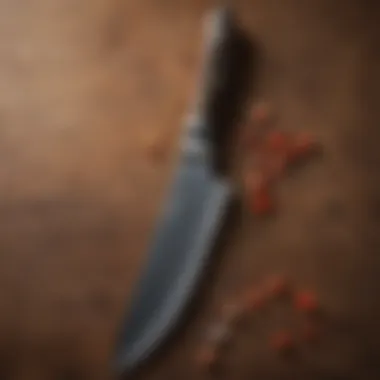
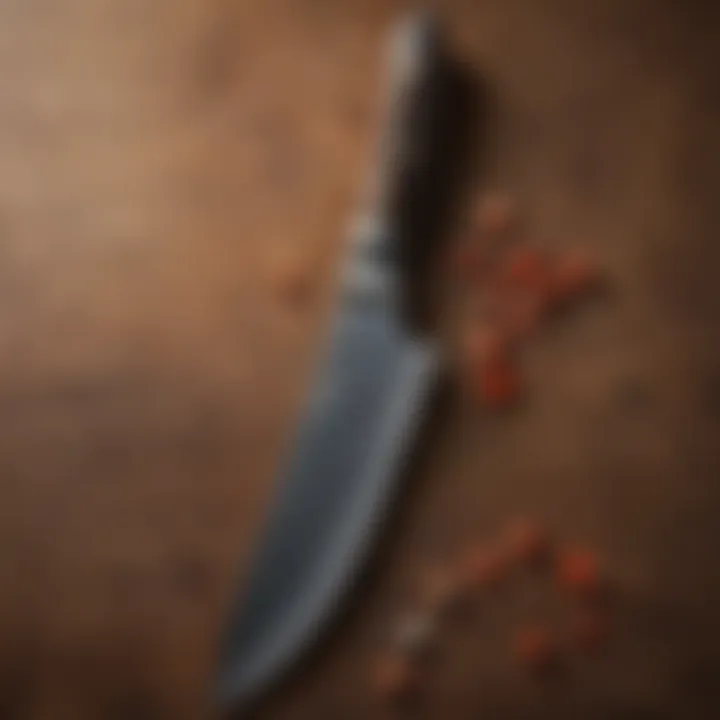
Specialty chef knives cater to specific cutting needs, providing solutions to the culinary tasks that may not be handled effectively by standard chef knives. The design of these knives helps in achieving specific cuts and preparing various types of food.
Some Notable Types Include:
- Paring Knife: Great for intricate tasks such as peeling or trimming.
- Fillet Knife: Perfect for deboning fish with a flexible blade.
- Bread Knife: With its serrated edge, it makes slicing bread effortless.
- Cleaver: Known for its hefty structure, suitable for chopping through bones.
In the kitchen, having a few specialty knives can enhance the efficiency of meal preparations. Each knife's specific design serves a purpose, making it necessary for home cooks to consider integrating them into their kitchen tools.
Selecting the right type of knife according to your needs significantly influences your cooking experience.
By understanding the different types of chef knives, home cooks can make a more informed decision when it comes to their knife selection. This will not only improve their cooking efficiency but also enhance the overall enjoyment of their culinary craft.
Key Features of a Good Chef Knife
When selecting a chef knife, understanding the key features is critical. Each feature plays a significant role in the performance and comfort of the knife, making it essential for home cooks to consider them closely. A high-quality knife enhances not only the efficacy of cooking but also the overall experience. The right balance of these features can transform meal preparation into a more enjoyable and efficient process.
Blade Material
The blade material is perhaps the most vital aspect of a chef knife. It directly affects durability, sharpness, and ease of maintenance. Common materials include stainless steel, high-carbon steel, and ceramic.
- Stainless Steel is popular for its corrosion resistance and maintenance ease. It provides a good balance of sharpness and durability, making it suitable for everyday use.
- High-Carbon Steel is renowned for its ability to hold a sharp edge longer. However, this material requires more care to prevent rust and damage. Chefs often prefer it for its exceptional cutting performance.
- Ceramic blades are lightweight and maintain their sharpness quite well. However, they are more brittle and may chip or break if not handled carefully.
Understanding these differences allows cooks to select a knife fitting their cooking habits and environment.
Blade Size and Shape
Blade size and shape influence how a knife performs in various tasks. Typically, chef knives range from 6 to 12 inches in length. A longer blade may provide more reach for slicing larger ingredients, while shorter blades offer more control when precision is required.
- Width is another consideration. Wider blades can facilitate rocking motions, essential for chopping.
- Curvature matters too; a blade with a more pronounced curve allows for better rocking while cutting herbs or vegetables.
- Tip shape varies as well, with pointed tips being excellent for detailed work. A more rounded tip is better for general chopping tasks.
Balancing size and shape provides a more tailored experience for the cook, fitting the specific cooking style or preference.
Handle Design
The handle design contributes significantly to the grip and control of the knife. A knife that feels comfortable in hand can reduce fatigue, especially for prolonged use. Several elements come into play when evaluating handle design.
- Material plays a crucial role. Hardwood, plastic, and metal are common choices. Each offers different aesthetics and grip comfort.
- Shape and Size need to feel ergonomic. A handle that fits well reduces the risk of slippage and offers better control, particularly when the knife is wet.
- Full Tang design, where the blade extends through the handle, provides balance and strength, enhancing overall performance.
A well-designed handle is not just about aesthetics; it fosters safety and comfort.
"A good chef knife should feel like an extension of your hand."
In summary, the blade material, size and shape, and handle design are pivotal in choosing a chef knife. Each feature interconnects, influencing performance, comfort, and the overall cooking experience for home cooks.
Selecting the Right Chef Knife
Selecting the right chef knife is a vital step in enhancing your cooking experience. A quality chef knife can significantly impact not only the ease with which you prepare meals but also the enjoyment you derive from the process. Without the proper knife, tasks such as chopping, mincing, and slicing can become frustrating. Therefore, understanding what best suits your needs is essential.
In this section, we will look at two key aspects: assessing your cooking style and considering your budget. Both elements play an important role in determining which chef knife will serve you best.
Assessing Your Cooking Style
Your cooking style is central to selecting the right chef knife. Consider how often and what types of meals you typically prepare. Are you inclined towards elaborate dishes or do you prefer quick and simple recipes? Understanding your habits can help identify the knife that will complement your cooking needs.
For instance, if you enjoy preparing complex cuisines, you may require a versatile chef knife with a broad blade. On the other hand, if you mostly make quick meals, a lightweight option may be more appropriate. Common cooking styles include:
- Home Cooking: A standard 8-inch Western chef knife is often suitable for various tasks.
- Baking: A precise knife may help with delicate cutting, like slicing cakes or fruits.
- Asian Cuisine: Consider a traditional Japanese knife, which offers a thinner blade for precision cuts.
Evaluate the variety of dishes you typically cook and choose a knife that matches the demands of your cooking habits. This thoughtfulness will not only improve your efficiency but also enhance the quality of your dishes.
Considering Your Budget
Budget is another critical factor when selecting a chef knife. It's tempting to think that a higher price guarantees better quality, but that is not always the case. Numerous excellent chef knives are available to fit a range of financial plans.
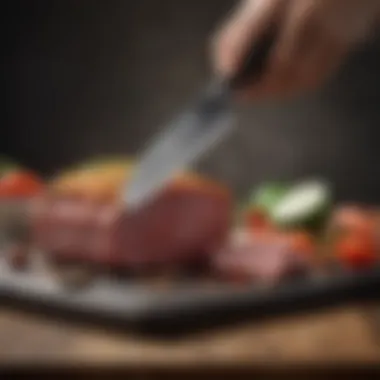
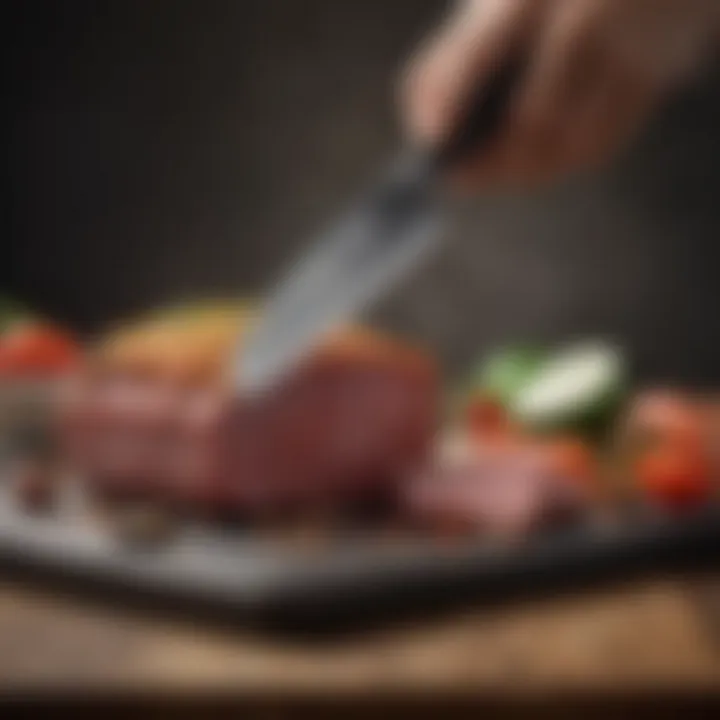
When establishing your budget, consider the following points:
- Quality versus Price: Examine knives within your budget that offer good steel and comfort, even if they are not the most expensive.
- Long-Term Investment: A quality knife can last many years if maintained properly. Consider investing more upfront for long-term satisfaction.
- Brand Reputation: Some brands have a proven track record for durability and performance. Research consumer feedback to guide your choices.
Ultimately, selecting the right chef knife does not always require breaking the bank, but thoughtful consideration of both your cooking style and budget will lead to a more satisfying culinary experience.
"The right knife is not just a tool, it’s an extension of your culinary passion."
Take these considerations into account, and you will be better poised to choose a knife that truly meets your needs.
Top Chef Knives Reviewed
Selecting the right chef knife can greatly influence a home cook's culinary experience. This section reviews specific chef knives that have garnered attention for their design, functionality, and user satisfaction. Understanding these products helps cooks make informed choices that align with their needs.
Recommended Western Chef Knives
Western chef knives are known for their robustness and versatility. They typically feature a broad blade that tapers to a sharp edge. Some of the most recommended options in the market provide a good blend of quality and price.
- Wüsthof Classic 8-Inch Chef's Knife: Recognized for its precision and durability. The full tang construction provides balance, and the high-carbon stainless steel blade resists stains and corrosion.
- Victorinox 8-Inch Chef’s Knife: Highly regarded for its affordability. It combines a lightweight handle with a perfectly balanced blade, making it suitable for both professional and casual cooks.
- Shun Classic 8-Inch Chef's Knife: A blend of traditional Japanese craftsmanship and Western design. Its VG10 steel core is clad with 16 layers of stainless steel, resulting in a blade that offers excellent sharpness and edge retention.
Recommended Japanese Chef Knives
Japanese chef knives, or gyoto, are revered for their exceptional sharpness and craftsmanship. These knives often feature thinner blades which allow for precise cuts. Some standout models include:
- Mizuno 210mm Gyuto: Handmade and features a comfortable D-shaped handle. The high-quality steel gives it impressive edge retention, making it a favorite among chefs.
- MAC Knife Professional 8-Inch Chef's Knife: Known for its thin edge and lightweight feel. The blade is made from high-carbon stainless steel, making it easy to sharpen and maintain.
- Tojiro DP Gyuto 240mm: Offers great value for money. Its combination of VG10 steel and traditional Japanese design makes it sharp while being reasonably priced.
Recommended Specialty Chef Knives
Specialty knives serve specific tasks, making them valuable tools in a kitchen. The following knives have proven to be efficient for distinct culinary jobs:
- Global G-48 7-Inch Vegetable Knife: Tailored for cutting vegetables. Its unique shape and extremely sharp blade enhance its efficacy in chopping and slicing.
- Henckels Pro 9-Inch Slicing Knife: Ideal for effortlessly slicing meats. The tapered edge allows for clean cuts, and the full tang construction ensures durability and balance.
- Ceramic Utility Knife by Kyocera: Known for its lightweight design and incredible sharpness. The non-reactive blade is excellent for slicing fruits and vegetables without altering their flavor.
"A quality chef knife is more than just a tool; it can transform the cooking experience and empower creativity in the kitchen." - Culinary Expert
Awareness of these top chef knives helps home cooks appreciate the diverse options available. Each knife reviewed offers distinct benefits suited to various culinary tasks, aiding in more informed purchasing decisions.
Maintaining Your Chef Knife
Maintaining your chef knife is crucial for both performance and longevity. A well-maintained knife offers the precision and efficiency needed in culinary tasks. Importance goes beyond mere aesthetic appeal; it ensures food preparation is safe and enjoyable. Regular maintenance includes cleaning, sharpening, and proper storage, each contributing to the knife’s overall effectiveness. Ignoring these aspects can lead to dull blades, compromise food safety, and increase the risk of accidents in the kitchen.
Cleaning Techniques
Cleaning your knife properly after each use is vital. Food residues can cause corrosion and dull the blade over time. After you finish cutting, rinse the knife under warm water to remove food particles. Avoid using a dishwasher, as high temperatures and detergents can damage the handle and blade. Instead:
- Hand wash with mild soap.
- Rinse thoroughly to remove all soap residues.
- Dry with a soft cloth, ensuring it is completely dry before storing.
Following these steps helps maintain the knife’s integrity and performance, ensuring it feels sharp every time you pick it up.
Sharpening Your Knife
Sharp knives are essential in the kitchen. Dull knives can slip while cutting, increasing the risk of injury. Regular sharpening keeps the blade refined, enabling precision cuts. There are several methods to sharpen a knife:
- Whetstone: This traditional method provides precise control over sharpening angles.
- Honing Steel: It realigns the blade edge and is used between sharpenings. It might not sharpen but keeps the edge aligned.
- Electric Sharpener: This is quick and easy for those unfamiliar with manual sharpening techniques.
Aim for sharpening your knife every few months, depending on usage. An edge that is maintained well can significantly enhance your cooking experience.
Storage Options
Proper storage of your chef knife ensures it stays sharp and safe to handle. Knives can be damaged if tossed in a drawer or improperly stored, which can lead to dulling or blade nicks. Consider these storage options:
- Knife Block: A wooden block not only protects knives but also presents them nicely.
- Magnetic Strip: This allows knives to be easily accessible and displayed while keeping blades out of contact with each other.
- Blade Guards: For those who prefer drawer storage, using blade guards can prevent scratches and cuts.
Choosing the right storage solution is key. It keeps your knifes sharp and prolongs their lifespan. Utilizing these methods ensures your knife is always ready when you’re in the kitchen.
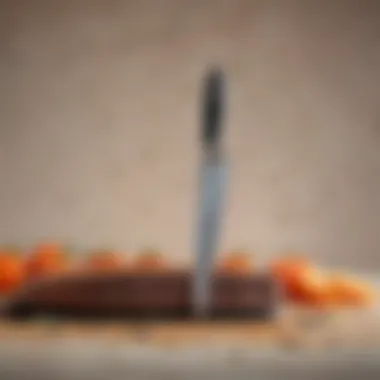
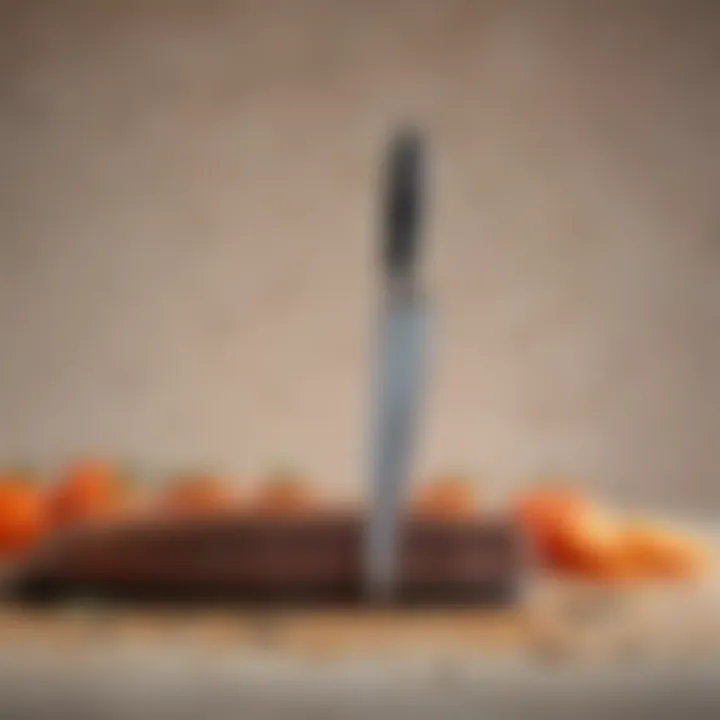
"A well-cared-for knife is a joy to use and makes cooking more pleasurable."
By investing time in maintaining your chef knife, you ensure that it serves you well in your culinary endeavors. The care you provide will enhance its functionality and make every cooking session more efficient.
Common Mistakes to Avoid
Selecting the right chef knife is crucial for any culinary endeavor. Understanding common mistakes when choosing and using chef knives can greatly enhance your cooking experience. This section emphasizes key pitfalls to steer clear of, ensuring you make informed decisions that lead to successful meal preparation.
Using the Wrong Knife for Tasks
It is important to understand that each chef knife is designed for specific tasks. Using the wrong knife can lead to inefficiency and potential safety issues. For example, using a delicate paring knife to slice through a butternut squash is not ideal. A heavier, sturdier knife such as a Western chef knife would perform much better.
Common mistakes can occur when cooks underestimate the importance of knife selection. Many may grab the first knife they see without considering its purpose. Different knives excel in slicing, chopping, or dicing, and using the correct one for each task enhances precision. Consider the following points:
- Mise en Place: Always prepare your ingredients before starting to cook. This practice helps clarify which tasks you need to accomplish and, consequently, which knife is appropriate to use.
- Education: Familiarize yourself with various types of knives and their functions. For example, learn the difference between a santoku and a cleaver; this understanding can save time and expand your culinary skills.
- Personal Comfort: Ultimately, select a knife that feels comfortable in your hand. Consider the weight and balance, which can greatly affect your ability to perform tasks effortlessly.
Using the right knife for each task not only enhances workflow but also improves the quality of the dishes you prepare.
Neglecting Maintenance
Neglecting knife maintenance is another common error that can undermine the overall effectiveness of your chef knife. Proper care includes regular cleaning, sharpening, and appropriate storage. Failing to maintain your knife can result in dull blades, which increases the effort required for slicing and chopping. This can also lead to accidents in the kitchen due to slipping or applying excessive force.
Here are key maintenance practices to keep in mind:
- Cleaning: Always clean your knife immediately after use. Avoid putting it in the dishwasher; instead, wash it with mild soap and warm water. This prevents the buildup of bacteria and protects the knife’s integrity.
- Sharpening: Regular sharpening is crucial for maintaining a good edge. Dull knives require more pressure to cut through food, which is not only inefficient but can also be dangerous. Invest in a sharpening tool or consider professional sharpening services.
- Storage: Store your knives properly to prevent dulling and damage. Consider using a knife block, magnetic strip, or blade guards. This reduces the risk of injuries and keeps your knives in good condition.
Proper maintenance is key for longevity and performance. Remember, a well-maintained knife enhances your capacity to prepare meals swiftly and with precision.
"A skilled chef knows that their tool is just as important as ingredients in achieving culinary excellence."
The Culinary Impact of a Quality Chef Knife
A quality chef knife plays a fundamental role in the kitchen. Its impact extends beyond mere functionality; it shapes the entire cooking experience. When selecting a chef knife, one should consider its influence on both precision and efficiency in culinary tasks. This section explores these elements and outlines the essential benefits of investing in a high-quality chef knife.
Enhancing Precision in Cooking
Precision is crucial in cooking. A high-quality chef knife can elevate this aspect significantly. First, the sharpness of the blade influences the accuracy of cuts. A sharper knife allows for cleaner, more precise slices, whether working with vegetables, meats, or herbs. This precision not only enhances the presentation of dishes but also affects cooking times. For example, evenly sized pieces cook more uniformly, leading to better flavor and texture.
Moreover, the balance of a well-crafted chef knife contributes to precision. A balanced knife allows for control, minimizing the chances of slipping while cutting. This stability gives the cook confidence, allowing for intricate techniques, such as julienne or chiffonade cuts. Consequently, the overall outcome of the dish improves.
In short, investing in a quality chef knife leads to improved precision, impacting both the aesthetics and cooking process of meals.
Boosting Efficiency in Meal Preparation
Efficiency is another compelling reason to choose a high-quality chef knife. The ability to handle various ingredients smoothly can save time and effort. A versatile chef knife can replace multiple kitchen tools, streamlining meal preparation. This versatility means less time searching for a specific knife and more time focusing on the actual cooking.
Additionally, a quality blade facilitates faster chopping, slicing, and dicing. Because of its design, a good chef knife can manage tough vegetables and delicate herbs equally well. This adaptability is particularly beneficial when preparing multiple dishes at once. You can complete tasks quicker without sacrificing quality or safety.
Quality matters in terms of durability, too. A robust knife can withstand frequent use without losing its edge. This reliability allows cooks to prepare meals efficiently over time, affording peace of mind during busy cooking sessions.
Finale
Choosing the best chef knife is not only about functionality; it encapsulates a deeper connection between the cook and the culinary process. A well-selected knife can transform the cooking experience, allowing for greater precision and creativity in the kitchen. Home cooks often overlook this important tool, but understanding its significance can lead to more enjoyable and efficient meal preparation.
When selecting a chef knife, consider your personal cooking style, preferences, and the types of ingredients you commonly use. The knife should feel comfortable in your hand, have a suitable weight and balance, and possess the features that enhance your cutting needs.
The right chef knife will greatly impact your efficiency and enjoyment in the kitchen, making it an indispensable tool. Ultimately, investing time and resources into finding the perfect knife will yield benefits that extend beyond the preparation stage.
In a world where culinary skills are continually evolving, equipping oneself with the right tools, like a quality chef knife, becomes essential. As home cooks strive to elevate their skills, they should prioritize this fundamental piece of equipment as a priority.
"A chef knife is more than just a tool; it is an extension of the cook’s hand, facilitating the creation of culinary art."
Final Thoughts on Choosing the Best Chef Knife
Choosing the best chef knife should not be rushed. Researching various types, features, and maintenance routines allows for a more informed decision. It is advisable to handle several knives to find one that fits your hand comfortably.
Also, considering the maintenance aspect is critical. A neglected knife will not perform optimally. Regular cleaning, sharpening, and proper storage should be part of your routine to ensure longevity.
Lastly, reflect on how much you value cooking. If you enjoy it as a form of expression or relaxation, investing in a quality chef knife becomes even more relevant. Your knife will serve as a reliable partner in your culinary adventures, helping you refine your skills and express your creativity in the kitchen.

